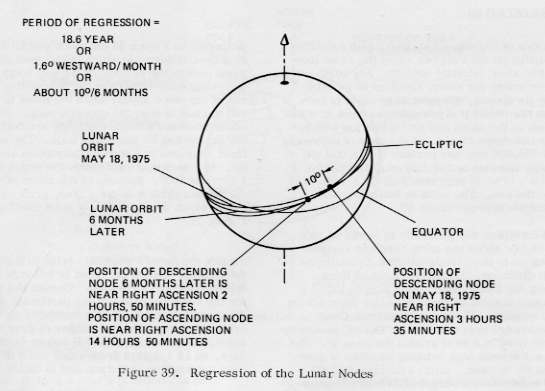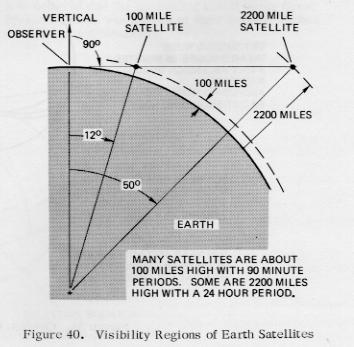

|
Earth satellites differ from other celestial objects in that they are much closer to the earth and the effect of parallax is pronounced. An observer seeing the moon overhead will observe the moon at a zenith distance of 0 degrees but if he moves 10° away, he will observe it a a distance of 10° plus a few minutes. If he moves about 89° away he will observe the moon at a zenith distance of 90° or on the horizon. Thus, the parallax of the moon is approximately 1 degree. If the observed object is an aircraft directly overhead at 1 mile altitude the observer need only move about 10 miles or 1/6 of a degree to observe the aircraft at a zenith distance of 90°. The parallax depends on the altitude of the object. Thus an artificial satellite in a 100 mile high orbit directly overhead to an observer will be on the horizon to an observer who is at a distance of 12° or 72 miles away. The 12° satellite spanner furnished with the Uniglobe represents the region around an observer for which a 100 mile high satellite will be above the horizon. If the satellite spanner is placed with its center over the observer's position and the satellite is within the 12° circle, it will be above the horizon of the observer. The spanner, when placed directly under the satellite will indicate the area in which a 100 mile high orbiting satellite will be visible. Refer to Figure 40. Figure 41 shows the use of the satellite spanner for a series of consecutive passes of a 100 mile high satellite around the earth. The great circle ring is placed over the celestial sphere to represent the satellite orbit. The earth globe is then rotated holding the celestial globe fixed. To determine when the satellite is visible, place the satellite spanner over the satellite's position in the orbit. To determine if an observer can sight the satellite, place the satellite spanner over the observer's position and note if the satellite's orbit passes through the ring. |
If it does, and if the satellite is in that part of the orbit that lies within the satellite spanner then the object is visible. Thus, in the figure, the satellite is not visible on the first two passes but is potentially visible on the third.
 |
| Page 22 |